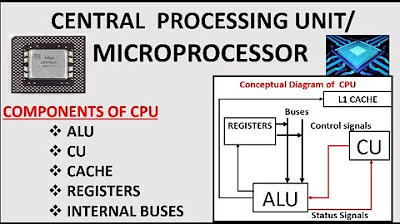How a control unit works inside a CPU
Summary
TLDRThis video explains the role of the control unit within a CPU. The control unit is responsible for managing the CPU's operations by decoding instructions and sending control signals to the data path. It ensures that the right operations, like reading from registers or executing arithmetic operations, are performed. The control unit interacts with the program counter (PC) to fetch instructions from memory, decodes them, and synchronizes the execution of operations, repeating this process in a loop. The video also provides examples of how the control unit handles different instructions, ensuring smooth operation of the CPU.
Takeaways
- 😀 The control unit is a key component of the CPU responsible for managing operations within the chip.
- 😀 The control unit generates control signals that direct the data path to execute specific tasks like reading registers and selecting operations.
- 😀 The control unit decodes instructions stored in the instruction register (IR), which contain binary data that indicates the required operation.
- 😀 The control unit is compared to a conductor of an orchestra, as it synchronizes various parts of the CPU to perform operations based on the decoded instructions.
- 😀 Before executing instructions, the control unit retrieves instructions from memory using the program counter (PC) to identify the correct memory address.
- 😀 The instruction register (IR) holds the current instruction, which is then decoded by the control unit to guide the CPU's behavior.
- 😀 The program counter (PC) holds the memory location of the next instruction to be fetched, and it is updated after each instruction is executed.
- 😀 The control unit manages a constant loop of fetching, decoding, and executing instructions, with each instruction requiring specific control signals for different operations.
- 😀 For each instruction, the control unit follows a sequence of steps: fetch the instruction, decode it, perform the required operations, and update the program counter.
- 😀 The control unit’s actions depend on the specific instruction, meaning different operations will trigger different sequences of control signals.
- 😀 The loop executed by the control unit ensures the CPU keeps fetching and executing instructions continuously until the program finishes.
Q & A
What is the primary function of the control unit in a CPU?
-The primary function of the control unit is to direct the operations of the CPU by providing the correct control signals to the data path components, ensuring that the right operations are executed.
What does the data path in a CPU do?
-The data path is responsible for processing data and performing operations, such as arithmetic or logical calculations, while also receiving control signals to modify its behavior.
How does the control unit determine which operations to execute?
-The control unit determines which operations to execute by decoding the instruction stored in the instruction register (IR). The decoding process interprets the binary encoding of the instruction and generates the necessary control signals.
What is the role of the instruction register (IR)?
-The instruction register (IR) stores the current instruction that is being executed by the CPU. This instruction is then decoded by the control unit to determine which operation to carry out.
How does the control unit get the next instruction to execute?
-The control unit gets the next instruction by using the program counter (PC), which holds the memory address of the next instruction to be fetched from memory.
What is the purpose of the program counter (PC)?
-The program counter (PC) holds the memory address of the next instruction to be fetched. It helps guide the control unit in fetching instructions from memory in the correct order.
Can you explain the sequence of steps the control unit follows to execute an instruction?
-The sequence begins with the control unit reading the instruction from memory (using the PC), storing it in the IR, then decoding it. After decoding, the control unit sends control signals to the data path to perform the necessary operations. Once the operation is completed, the PC is updated to point to the next instruction.
What happens when the instruction involves an arithmetic operation like addition?
-For an addition instruction, the control unit generates signals to read values from the appropriate registers, selects the operation to be performed in the ALU, and stores the result in the destination register.
How does the control unit handle instructions that involve reading and writing to memory?
-When an instruction involves memory operations, such as storing data in memory, the control unit fetches the instruction from memory, decodes it, and then performs actions like reading the value from the register and writing it to the specified memory address.
Why is the iterative loop of fetching, decoding, and executing instructions important for the CPU?
-The iterative loop is crucial because it allows the CPU to continuously execute programs by processing one instruction at a time. The loop ensures that the CPU can handle any series of instructions in a sequential and synchronized manner.
Outlines

This section is available to paid users only. Please upgrade to access this part.
Upgrade NowMindmap

This section is available to paid users only. Please upgrade to access this part.
Upgrade NowKeywords

This section is available to paid users only. Please upgrade to access this part.
Upgrade NowHighlights

This section is available to paid users only. Please upgrade to access this part.
Upgrade NowTranscripts

This section is available to paid users only. Please upgrade to access this part.
Upgrade NowBrowse More Related Video
5.0 / 5 (0 votes)





